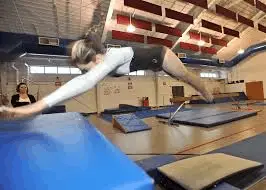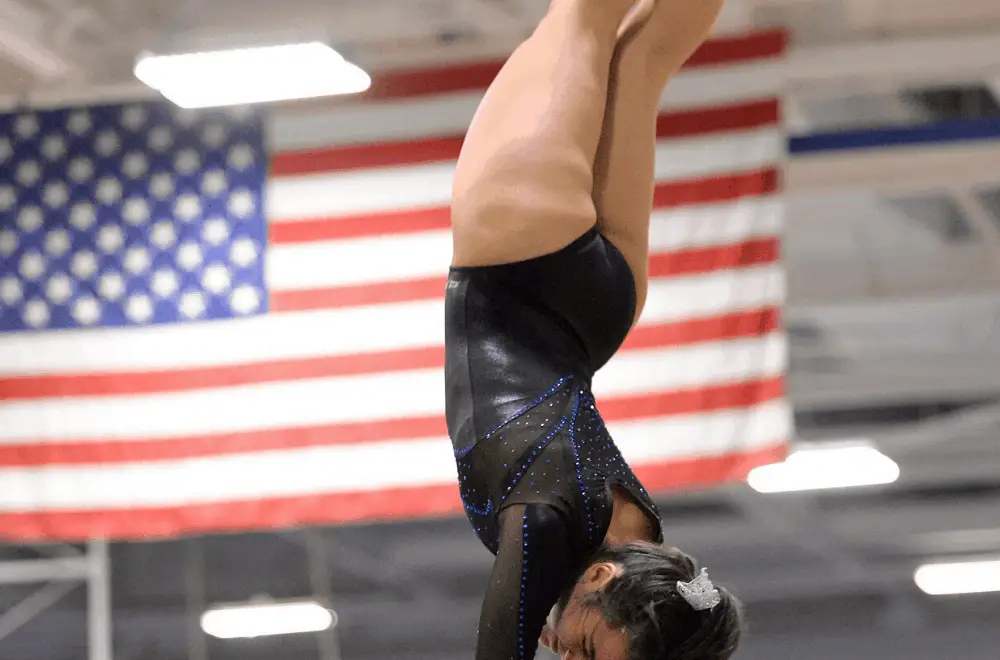This article has been updated to reflect the changes in the 2022-26 Xcel Code of Points.
Ah, Xcel. These are the levels that foster the most questions. There are so many questions that our regional Xcel chair even started a Xcel Facebook group. Professionals in our region can write in to the group to get their questions answered. I always have to do extra review of the Xcel rules before every meet, to be sure I understand all the nuances. And now, I’m excited to pass along the information I’ve learned, through a series of Xcel articles. Today, we’ll talk about Xcel vault.
Disclaimer – sometimes you’ll see me compare Xcel divisions to their equivalent J.O. levels. I feel like this helps me to better understand the purpose of the level, even though the deductions may be different. Also, I intuitively understand the J.O. level system better than the Xcel system. It has taken me MANY years to get used to judging Xcel gymnastics, and while the system has improved greatly over the years, there are still aspects of the rules that make me question the rationale.
But that’s another story for another time. Now, on to Xcel vault.
Xcel Bronze Vault
There are two options for Bronze Vault. Option 1 has a Start Value of 9.0, and Option 2 has a Start Value of 10.0. Coaches can choose which vault their gymnast should do based on her level of ability and scoring potential for each vault.
For all vaults, the spotting deductions are as follows: 0.50 for a spot on landing, and 1.0 for a spot in any other phase. The total maximum spotting deduction is 1.5. These spotting deductions are the same for all divisions.
Bronze Vault Option 1 (SV 9.0):
Option 1 consists of two parts, each worth 4.5, for a total Start Value of 9.0.
Part A: Straight jump onto 16-48″ mat; AND Part B: Kick to handstand (hands on board or mat) fall to flat back.
The emphasis during both parts of this vault is on good, straight body position. Similar to compulsory vault, there are deductions for piked body (up to 0.50), arched body (up to 0.30), leg separation (up to 0.20), and foot form (up to 0.10). These deductions all apply to both portions of the vault. There are really no “phases” of either vault (the vaults are broken down into approach and vault), so each of these deductions can only be taken once per part.
Vault 1A: Straight jump
The straight jump is expected to show height onto the mat stack (up to 0.50). If the gymnast is unable to reach the mat without bending her knees, she would receive this height deduction along with the up to 0.50 deduction for tucked legs in the air. The arms should reach the ears, with a deduction of up to 0.30 for poor arm and head alignment. There is also an up to 0.50 deduction for control and body position on the landing. If the gymnast takes steps, hops, or wobbles on the landing, or lands with the chest low, this deduction applies. There are also a few small deductions for foot position on landing, consistent with the landing deductions in the DP Program. To avoid deduction, the gymnast should stick her landing with feet next to each other, and no more than hip-width apart.
Bronze vault 1A differs from all other Xcel vaults in that the approach is judged. During part A, deductions can be taken for double bouncing on the board in part A (0.30 each). If the gymnast steps onto the mat stack or lands in support on any body part other than her feet first, the part A vault is void. As in all other vaults, there is an up to 0.30 deduction for dynamics. The gymnast should generate excellent speed and power during the run and jump up to the mat stack.
Vault 1B: Handstand fall to flat back
Part B of this vault has additional deductions for the handstand position. The largest deduction is up to 2.00 for performing a forward roll instead of a handstand flat back. If the gymnast does not stay completely stretched during the fall to flat back, this deduction is taken. Then, if she does not land in a stretched flat back position, she can lose up to 1.00 for her landing position.
The gymnast should keep her arms next to her ears while moving into the handstand (up to 0.20). An extra kick to handstand is considered a fall (0.50). Once her hands touch the mat, there is an up to 0.30 deduction for a shoulder angle, up to 0.50 for bent arms, and 0.10 each for steps/hops on the hands.

Bronze Vault Option 2 (SV 10):
Option 2 is a jump to handstand, fall to flat back on a 16-48″ mat. No repulsion is required.
The alternative springboard is allowed.
This vault is similar to the compulsory Level 2 vault, with some differences in the deductions. First, the run and approach is not judged. There are general deductions which apply to each phase, and are similar to compulsory deductions:
- Piked body: up to 0.50 each phase
- Arched body: up to 0.30 each phase
- Bent legs: up to 0.30 each phase
- Leg separation: up to 0.20 each phase
- Poor foot form: up to 0.10 each phase
- Incorrect head alignment: up to 0.10 each phase
The biggest deduction is for performing a rolling movement instead of a fall to flat back, which is an up to 2.00 deduction. Other large deductions include contacting the mat when the body is past vertical (up to 1.00) and failure to land in a flat back position (up to 1.00). Bent arms are an up to 0.50 deduction, but if the bent arms cause the head to touch the mat, the deduction increases to 2.00.
Xcel Silver Vault
Just like Bronze, Xcel Silver gymnasts have the choice of two vaults. Both Silver vaults start at 10.0. The alternative springboard is allowed for either vault, and the Start Value stays the same. A sting mat is allowed, as long as it is placed on the landing mat only.
Silver Vault Option 1 (SV 10):
The first option for silver vault is a Handspring over the sideways mat stack. Here’s a video:
Silver Vault Option 2 (SV 10):
The second option for Silver vault is the Half on, repulsion off over sideways mat stack, landing facing mat stack. The gymnast is allowed to perform a 1/4 on or 1/2 on. Any additional twist results in a VOID vault.
Here’s a video of a half-on over the table, because I didn’t have a video of a half-on over the sideways mat stack.
Silver vault has its own set of deductions. Here are some important ones:
- Piked body position: Up to 0.50 (all phases)
- Arched body position: Up to 0.30 (all phases)
- Leg separation: Up to 0.20 (all phases)
- Bent knees: Up to 0.30 (1st/2nd flights)
- Legs crossed: Up to 0.10 (1st/2nd flights)
- Foot form: Up to 0.10 (1st/2nd flights)
- Poor head position: Up to 0.10 (all phases)
- Bent arms: Up to 0.50 (slight bend of lead arm is ok for the 1/2 on)
- Too long in support: Up to 0.30
- Steps/hops on hands: 0.10 each
- Brush/hit of body/head on mat stack during 2nd flight: Up to 0.20
The deductions that are surprisingly missing from Silver vault are height and distance. Typically, those are deductions that occur on most vaults, and it’s very odd not to use them. The emphasis for the Silver division is on body position and learning to go over the mat stack. We can use the dynamics deduction (up to 0.30) and too long in support to differentiate those vaults that have excellent power from those that do not, but primarily the judges are evaluating body, shoulder, and head position.
Xcel Gold Vault
Allowed vaults are from the Xcel Gold Vault Chart. All allowable vaults are worth 10.0. The alternative springboard is allowed, but the Start Value of the vault lowers to 9.5 if the gymnast uses the alternative springboard.
The deductions are the same for Gold, Platinum, and Diamond vault. Here are some deductions that may occur during Gold and Platinum vaults (all Gold and Platinum vaults are non-salto vaults).
Amplitude/Dynamics Deductions
- Too long in support: Up to 0.50
- Insufficient height: Up to 0.50
- Insufficient distance: Up to 0.30
- Brush/hit of body/head on table during postflight: Up to 0.20
- Insufficient dynamics: Up to 0.30
- Steps on the hands (on the table): 0.10 each
The deductions in this category are large for a reason. The main focus of a vault is to generate speed, height, and power. The run is not judged, but that doesn’t mean it’s not important. The best vaults begin with a strong, powerful run. The speed from the run will convert into height and rotation after hitting the springboard. The parts of the vault that are judged are the results of the run and the block off the table.
Body Position Deductions
- Legs crossed: Up to 0.10 (preflight/postflight)
- Leg separation: Up to 0.20 (preflight/postflight)
- Bent knees: Up to 0.30 (preflight/postflight)
- Piked body: Up to 0.20 (preflight/postflight)
- Arched body: Up to 0.20 (preflight/support), Up to 0.30 (postflight)
- Failure to maintain stretched body: Up to 0.30 (2nd flight)
- Shoulder angle: Up to 0.20 (support phase)
- Alternate hand placement: Up to 0.10 (support phase)
- Alternate repulsion: Up to 0.20 (support phase)
Good body position is important on every event, and vault is no exception. Form deductions apply to the 1st and 2nd flights. This means that if the gymnast has bent knees and a leg separation throughout the vault, her deductions multiply. The deduction for an arched body applies to all three vault phases. There are additional deductions in the support phase for the shoulder and hand position. These deductions add up throughout the vault, to show the importance of good body position. Body position faults during basic vaults can lead to difficulty learning more difficult vaults.
Deductions for Twisting Vaults
- Incomplete LA turn in preflight: Up to 0.30
- Not passing through vertical on vaults w/turn in preflight: Up to 0.30
- LA turn begun too early (during support phase instead of 2nd flight): Up to 0.30
- LA turn begun too late: Up to 0.50
- Late completion of twist: Up to 0.30
- Insufficient exactness of LA turn: Up to 0.10
- Incomplete LA turn upon landing: Up to 0.30
There are a LOT of deductions related to the twist. If the gymnast cannot perform a twisting vault crisply and cleanly, with the twist complete in each phase, she will be better off doing a handspring. In Gold, the Start Value is the same, and in Platinum, the Start Values are so close that deductions of more than 0.20 would mean that it doesn’t make sense to do the twisting vault. At any level, it’s acceptable to do two different vaults and ask for the score of the first vault. This can help coaches to make the best decision about which vault to do, while allowing the gymnast to gain experience competing the more difficult vault.

Xcel Platinum Vault
Allowed vaults are from the Xcel Platinum Vault Chart. The vaults are mostly the same as the Gold chart, but Start Values vary between 9.7 and 10.0 depending on the difficulty of the vault.
The big difference is that at Platinum, gymnasts are allowed to do a roundoff-entry (Yurchenko) vault, with either a repulsion off or a 1/2 twist off.
The alternative springboard is NOT allowed at Platinum, or the vault is void.
See the Gold section for deductions that may occur during a Platinum vault.
Xcel Diamond Vault
Allowed vaults are from the Xcel Diamond Vault Chart. Start Values are listed on the vault chart.
Diamond athletes can perform the same vaults as Gold and Platinum athletes, but they may also perform more difficult vaults, including salto (flipping) vaults.
The Diamond vaults are subject to all of the same deductions as the Gold and Platinum vaults. In addition, there are deductions that can be taken for body position and opening of a salto vault. Here are some of these deductions:
- Under-rotation of salto vaults: Up to 0.10
- Insufficient exactness of body position: Up to 0.30. This includes insufficient tuck, pike, or stretch, as well as arched body.
- Failure to maintain stretched body (pikes down a layout): Up to 0.30
- Lack of extension/open before landing: Up to 0.30
Failure to extend, or open, before landing is one of the most common deductions for a flipping vault. This deduction is commonly taken along with a body posture deduction on the landing, and those deductions can really add up! If a gymnast never opens and lands with her chest completely down, she will lose 0.30 for open + 0.20 for posture = 0.50!
Closing Thoughts
That’s your basic overview of Xcel vault at all levels. One set of deductions I didn’t really discuss is landing deductions, since they are pretty straightforward and common to all levels. Unlike what you’ll hear on TV, what happens DURING the vault is much more important than what happens on the landing (aside from falls). A strong run, good body position, and a big block off the table (for the higher levels) will result in great scores!
Want more vault resources? Check these out:
5 Tips for a Stellar Handspring Vault
Tips and Resources to Build Your Level 6/7 Vault Score
And here are some more Xcel articles:
Xcel Bars: Bronze, Silver, and Gold
Xcel Bars: Platinum and Diamond
How to Score Big on Xcel Floor
References: USA Gymnastics Women’s Xcel Code of Points, 2022-2026.
